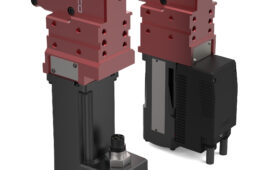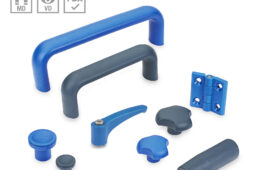Written by Jody Muelaner

A stramp camp is a holding device, with a stramp or band that can tighten around an assembly to enable bonding or welding.
Strap clamps, also known as band clamps, resemble the ratchet straps used to tie down loads, such as on a roof rack or truck. The webbing strap is placed around an assembly and tightened to apply pressure to joints. They’re also often used to apply pressure while bonding joints in woodwork or when welding joints in fabrication.
Typically, strap clamps are fitted with four corner guides, for use in a rectangular arrangement. The guides prevent the corners of the parts from getting crushed when a load is applied. At the same time, they enable the straps to slide freely so that an even amount of pressure is applied around the assembly. Special purpose clamps may have guides in other configurations.
Different mechanisms may be used to tighten the strap. The most common is a screw that’s incorporated into one of the four corner guides. In this arrangement, the straps are first pulled tight by hand before being locked off with cams on either side of the screw. The screw is then used to draw the cams away from the corner guide, causing the strap to tighten around the assembly.
The straps are most commonly made of textile webbing material. The guides and clamp body are made from plastic. Some heavy-duty strap clamps use metal banding instead of webbing and may be referred to as band clamps.
Sometimes ratcheting load straps are used as strap clamps if they’re what’s available. In these cases, corner guides may also be easily fashioned from scrap material, and ideally a polymer with little friction.
However, a simpler way of improvising a strap clamp is to tie a loop of webbing or rope around the parts to be clamped and then insert a bar which can be wound to twist the loop, causing it to tighten. The bar can then be tied off to prevent it from unwinding.





Tell Us What You Think!